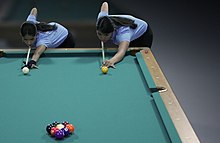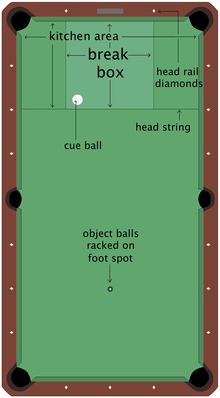Nine-ball
Cue sports equipment | |
| Glossary | glossary of cue sports terms |
|---|---|
| Presence | |
| Country or region | Worldwide |
| World Games | 2001 |
Nine-ball (sometimes written 9-ball) is a discipline of the
The game is currently governed by the
Nine-ball has been played with varied rules, with games such as ten-ball, seven-ball and three-ball being derived from the game. While usually a singles sport, the game can be played in doubles, with players completing alternate shots. Examples of tournaments featuring doubles include the World Cup of Pool, World Team Championship and the Mosconi Cup.
History
The game was established in America by 1920,[1][2] although the exact origins are unknown.[3][4] Nine-ball is played with the same equipment as eight-ball and other pool games.
Rules
The game of nine-ball is played on a
Breaking

Each rack begins with the object balls placed in a rack and one player playing a break.[6] The object balls are placed in a diamond-shaped configuration, with the 1-ball positioned at the front on the foot spot, and the 9-ball placed in the center. The rack used to position the balls may be either triangle-shaped, as is used for eight-ball and other pool games, or a specific diamond-shaped rack that holds only nine balls may be used. Racks are usually made of wood or plastic.[7] A template that lies on the table during the break has also come into use.[7]
The break consists of hitting the 1-ball, with the attempt to pocket any ball. If the nine-ball is successfully potted, the player automatically wins the rack. This is sometimes known as a golden break.[8] Additional rules in some tournaments exist, such as a number of balls having to reach the head string, and players can be chosen to break alternately or whoever won the preceding rack. The break is often the most crucial shot in nine-ball, as it is possible to win a rack without the opponent having a single shot. This is often called a break and run, or running the rack.[9] Earl Strickland holds the record for break and runs, after he successfully ran 11 consecutive racks in a tournament in 1996.[10] The first break of a match is sometimes decided by a flip of a coin, but often by playing a lag, with both players playing a cue ball down the table, the closest to the top rail winning the initial break.[5][11]
Push out and fouls
After the break, if no fouls were committed, the shooter has the option to continue the rack as usual, or to play a push out. The rules on a push out are different to those of a regular shot, as the shot does not need to hit a rail or ball.[12] After the push out, the opposing player has the option to play the shot that has been left, or to force their opponent to play on from that location. In early versions of nine-ball the push out could be called at any time during the game, but is now only for the shot after the break.[12][5][13]
If a player misses potting a ball on a shot, or commits a foul shot, then their opponent plays the next shot.[5] A foul shot can involve not making first contact with the lowest numbered ball, pocketing the cue ball, or not making contact with a rail with the object ball.[6] A foul shot for any reason offers the opponent ball in hand, which means they can place the cue ball at any location on the table. A player making three successive fouls (for any reason) awards that rack to the opponent.[6] Unlike some other cue sports, such as snooker, players are allowed to jump the cue ball over other balls. However, if any ball leaves the cloth at the end of a shot, it is counted as a foul. Jumping is common in nine-ball, and players often have a dedicated jump cue.[14]
European alterations

As of the 2000s, the rules have been somewhat in flux in certain contexts, especially in Europe. The European Pocket Billiard Federation (EPBF), the WPA-affiliate in Europe, has instituted a requirement on the Euro Tour is that the break shot be taken from a "break box" a rectangular box smaller than the regular nine-ball breaking area.[13][15] While making the money ball on breaks are still possible, they are much more difficult with the break box.[13] This was later used on the annual international Mosconi Cup tournaments.[16] Another Mosconi Cup rule change in 2007 called for racking such that the 9-ball rather than the 1-ball is on the foot spot, which further stops overpowered break-off shots.[13]
Governance
The general rules of the game are fairly consistent and usually do not stray too far from the earliest format set by the Billiard Congress of America (BCA).[17] These later formed the basis of the standardized WPA rules, which the BCA follows as a member, although amateur league play may be governed by similar but slightly different rules promulgated by the American Poolplayers Association (APA) and other organizations.[5]
Tournaments
Nine-ball events worldwide are run at the highest level by the WPA. The
In addition, Matchroom Sport runs major international competitions including the Mosconi Cup, World Cup of Pool and World Pool Masters.[21]
Outside those events held on an worldwide basis, nine-ball is played in continental tour series. Events are held on series such as the Diamond Pool Tour,[22] Asian Tour and Euro Tour.[23][24]
Derived games

Several games have been derived from nine-ball. Six-ball is essentially identical to nine-ball but with three fewer balls, which are racked in a three-row triangle, with the money ball placed in the center of the back row.[25] According to Rudolf Wanderone, the game arose in early 20th century billiard halls; halls charged for matches by the 15 ball rack rather than by table, so players of nine-ball had six balls left over.[25] For this reason, the game is often played with the balls numbered between 10 and 15, with the 15-ball as the money ball.[25]

Seven-ball is also similar to nine-ball, though it differs in two key ways: the game uses only seven object balls, which are racked in a hexagon, and players are restricted to pocketing the money ball on their designated side of the table. William D. Clayton is credited with the game's invention in the early 1980s.[26] While not a common game, it was featured on television broadcaster ESPN's Sudden Death Seven-ball which aired in the early 2000s.[25]

The most common derivative game is the game of ten-ball. The game is a more stringent variant, using ten balls in which all pocketed balls must be called. Unlike in nine-ball, the money ball cannot be pocketed on the break for an instant win. Due to its more challenging nature, and the fact that there is no publicly known technique for reliably pocketing specific object balls on the break shot, there have been suggestions among the professional circuit that ten-ball should replace nine-ball as the pro game of choice,[13] especially since the rise of the nine-ball soft break, which is still legal in most international and non-European competition.[13] Ten-ball has its own world championship known as the WPA World Ten-ball Championship.[27]
Popular culture
The sport has featured in popular culture, most notably in the 1959 novel
See also
- List of WPA World Nine-ball Champions
- Glossary of cue sports terms
 Cue sports portal
Cue sports portal
References
- ^ "The History of Billiards". cuecare.com. Archived from the original on 9 February 2007. Retrieved 10 November 2006.
- ^ Hikock, Ralph. "Sports history – Billiards". hickorysports.com. Archived from the original on 23 February 2002.
- Coralville, IA: Billiard Congress of America (BCA). 1998. p. 26.
- ^ Hickok, Ralph (2001). "Sports History: Pocket Billiards". hickorysports.com. Archived from the original on 5 December 2006. Retrieved 13 December 2006.
- ^ a b c d e f "Billiard Congress of America". bca-pool.com. Archived from the original on 23 November 2004. Retrieved 6 January 2020.
- ^ a b c "9 – Ball Rules". vnea.com. Archived from the original on 18 May 2019. Retrieved 6 January 2020.
- ^ a b "Billiards Racks Dimensions & Drawings | Dimensions.Guide". dimensions.guide. Retrieved 6 January 2020.
- ^ "Golden Break". billiardsforum.com. Archived from the original on 1 March 2019. Retrieved 6 January 2020.
- ^ "Break and Run". billiardsforum.com. Archived from the original on 2 July 2019. Retrieved 6 January 2020.
- ^ "Billiards Digest – Pool's Top Source for News, Views, Tips & More". billiardsdigest.com. Archived from the original on 18 January 2017. Retrieved 6 January 2020.
- ^ "Starting Strong: How to Win the Lag | Pool Cues and Billiards Supplies at PoolDawg.com". pooldawg.com. Retrieved 6 January 2020.
- ^ a b "Rules of Play". WPA Pool. Retrieved 14 May 2020.
- ^ ISSN 0164-761X.
- ^ "How To Massé and Jump the Cue Ball | Pool Cues and Billiards Supplies at PoolDawg.com". pooldawg.com. Retrieved 6 January 2020.
- ISSN 0164-761X.
- ^ "Break rules set to change". kozoom.com. Retrieved 7 January 2020.
- ^ "BCA World Standardized Rules for Nine Ball". BCA pool. Archived from the original on 23 November 2004.
- ^ "European Pool Rankings" (PDF). europeanpocketbilliardfederation.com. Retrieved 6 January 2020.
- ^ "WPA Ranking". WPA Pool. Archived from the original on 23 September 2012. Retrieved 6 January 2020.
- ^ Behrman, Barry (7 July 2011). "Statement From Barry Behrman and Shannon Berhman Paschall-Exclusive to AZB". AzBilliards.com. Archived from the original on 16 July 2011. Retrieved 15 July 2011.
- ^ "Pool". Matchroom Sport. Archived from the original on 24 December 2019. Retrieved 6 January 2020.
- ^ "Diamond Pool Tour". azbilliards.com. Archived from the original on 10 June 2017. Retrieved 7 January 2020.
- ^ "Womens Eurotour". europeanpocketbilliardfederation.com. Archived from the original on 22 June 2019. Retrieved 7 January 2020.
- ISBN 9780785826026. Retrieved 7 January 2020.
- ^ ISBN 9781558217973– via Internet Archive.
- ISBN 1-55821-219-1.
- ^ "Predator World 10-Ball Championship – Las Vegas (2019-07-22)". WPA Pool. Archived from the original on 28 June 2019. Retrieved 6 January 2020.
- ^ Rossen, Robert (1972). Three Screenplays: All the Kings Men, The Hustler, and Lilith. New York, Anchor Doubleday Books. LCCN 70-175418.
- ^ "Review: Hustler, The". preview.reelviews.net. Retrieved 7 January 2020.
- ^ "'The Color of Money': Three Men and a Sequel". The New York Times. Retrieved 7 January 2020.

